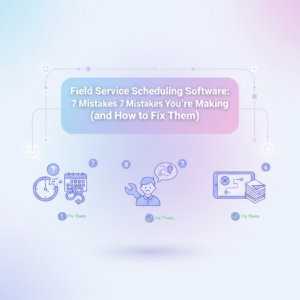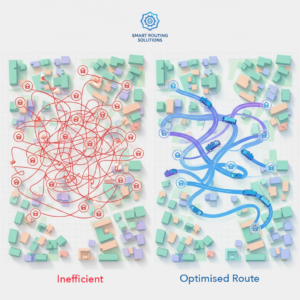Field Service Scheduling Software: 7 Mistakes You’re Making (and How to Fix Them)

Field service scheduling can make or break your business operations. While the right software transforms productivity and customer satisfaction, common mistakes can drain resources and damage your reputation. You’re likely making at least one of these critical errors that’s costing you time, money, and customers.
Let’s dive into the seven most damaging field service scheduling mistakes and discover how to fix them before they impact your bottom line.
Mistake #1: Sending Technicians Without Remote Troubleshooting First
Your biggest scheduling mistake might happen before you even create a work order. When service requests come in, many companies immediately dispatch technicians without attempting remote troubleshooting first. This knee-jerk reaction wastes valuable resources and creates unnecessary costs.
Smart dispatchers review asset history and service records before scheduling field visits. Remote engineering teams can often resolve issues through phone guidance, remote diagnostics, or simple customer instructions. When remote troubleshooting fails, you can ensure the right technician arrives with proper parts and equipment.
How to Fix It: Implement a systematic troubleshooting protocol that starts every service request remotely. Create checklists for common issues that customers can verify before scheduling onsite visits. When field visits become necessary, conduct complete availability checks for parts, personnel, and equipment. This approach reduces follow-up visits while improving customer experience and your profit margins.

Mistake #2: Relying on Manual Scheduling Procedures
Manual scheduling feels familiar, but it’s killing your efficiency. Experienced dispatchers can handle routine daily schedules, but they struggle when work orders exceed capacity or emergency requests arrive. Without automated scheduling software, your team lacks visibility into technician locations, skills, and availability.
Manual processes become especially problematic during peak demand periods. Dispatchers spend hours organizing schedules instead of focusing on revenue-generating activities. Customer service suffers when you can’t respond quickly to urgent requests or optimize technician utilization.
How to Fix It: Invest in comprehensive field service scheduling software that provides real-time automation and visibility. Look for solutions that automatically match technician skills with job requirements, optimize routes, and provide instant updates on availability. The right software transforms scheduling from a time-consuming burden into a strategic advantage.
Mistake #3: Failing to Provide Optimized Driving Routes
Poor routing decisions cascade into multiple operational problems. Technicians arrive late, miss appointments, and fail to complete scheduled tasks within required timeframes. Your dispatchers must manually navigate complex variables including technician eligibility, location, availability, and skill inventories for each job assignment.
Without route optimization, your technicians spend excessive time driving between appointments instead of generating revenue. Fuel costs increase, customer satisfaction decreases, and your team’s productivity plummets. Geographic inefficiencies compound daily, creating significant hidden costs.
How to Fix It: Implement routing optimization features that consider technician skills, current location, and appointment priorities. Modern scheduling software automatically creates efficient travel paths that minimize drive time while maximizing daily appointment capacity. Real-time traffic integration helps your team navigate around delays and maintain on-time performance.

Mistake #4: Poor Service Demand Forecasting
Failing to predict service demand accurately creates scheduling chaos. Understaffing leads to missed appointments and frustrated customers, while overstaffing drains your finances and reduces profitability. Most companies react to demand fluctuations instead of anticipating them.
Seasonal patterns, equipment age cycles, and historical data provide valuable insights for workforce planning. Without proper forecasting, you’re constantly scrambling to adjust schedules, often disappointing customers and overwhelming technicians during busy periods.
How to Fix It: Use historical data and analytics to identify demand patterns and seasonal trends. Your scheduling software should track peak service periods, common equipment failures, and customer request patterns. This information enables better workforce planning, more accurate capacity management, and proactive scheduling that keeps customers satisfied.
Mistake #5: Inadequate Customer Communication
Poor customer communication disrupts even perfect schedules. When your dispatch team lacks real-time updates on appointment progress, they can’t provide customers with accurate arrival times. This communication gap leads to scheduling conflicts, missed appointments, and frustrated customers.
Customers expect transparency about technician locations and realistic arrival windows. Without automated communication systems, your team spends valuable time manually updating customers instead of focusing on operational improvements. Missed communications often result in customer unavailability during scheduled appointments.
How to Fix It: Choose field service software that automatically sends appointment reminders through text messages, calls, and emails. Implement real-time tracking that provides customers with accurate technician locations and updated arrival times. Proactive communication increases customer availability and reduces scheduling disruptions.

Mistake #6: Choosing Software Based on Cost Alone
Selecting field service management software purely based on price creates long-term operational problems. Low-cost solutions frequently lack essential features, forcing you to accept inefficiencies or pay for expensive add-ons and integrations. A seemingly budget-friendly solution often becomes costly when it requires frequent modifications or fails to support business growth.
Hidden costs emerge quickly with inadequate software. Training time increases, productivity decreases, and you may need additional tools to fill functionality gaps. The total cost of ownership includes implementation, ongoing support, scalability limitations, and lost productivity during transitions.
How to Fix It: Evaluate the total cost of ownership rather than just upfront pricing. Consider implementation costs, training requirements, scalability options, and long-term support needs. Focus on value and functionality that align with your operational requirements. The right investment pays dividends through improved efficiency and customer satisfaction.
Mistake #7: Overlooking Customization and Flexibility Needs
Many field service platforms force your operations to conform to rigid, one-size-fits-all approaches. This inflexibility creates operational inefficiencies, requires manual workarounds, and frustrates your team. Without customizable workflows, reporting dashboards, and role-based permissions, you cannot maximize your software investment.
Standard configurations rarely match your specific business processes. Technicians work differently, customers have varying requirements, and your reporting needs are unique. Software that doesn’t adapt to your operations becomes a constraint rather than an enabler.
How to Fix It: Prioritize solutions that offer easy configuration without requiring extensive developer involvement. Ensure your chosen software can adapt to your business processes rather than forcing operational changes. Look for platforms that allow workflow customization, flexible reporting, and adjustable user permissions that match your specific organizational needs.

Transform Your Scheduling Operations
These seven mistakes cost field service companies thousands of dollars annually through reduced efficiency, customer dissatisfaction, and missed opportunities. The good news is that recognizing these problems puts you ahead of competitors who continue making the same costly errors.
Modern field service scheduling software addresses each of these challenges through intelligent automation, real-time visibility, and flexible configuration options. The right solution integrates seamlessly with your existing systems, scales with business growth, and provides the adaptability needed for changing operational requirements.
You don’t have to accept scheduling inefficiencies as inevitable business costs. By addressing these common pitfalls proactively, you can improve scheduling efficiency, enhance customer satisfaction, and drive better business outcomes. Your technicians will spend more time serving customers and less time dealing with scheduling conflicts, route inefficiencies, and communication breakdowns.
Ready to eliminate these costly scheduling mistakes and transform your field service operations? The right scheduling software investment pays for itself through improved efficiency, customer satisfaction, and operational excellence
